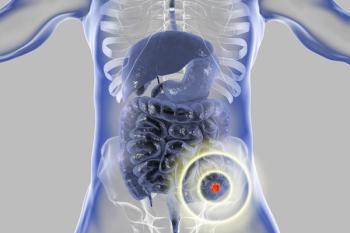
Scenario 1: ctDNA to Determine Use of Adjuvant Chemotherapy in Stage II CRC
Centering discussion on a patient scenario of stage II colorectal cancer, expert oncologists consider how ctDNA may inform use of adjuvant chemotherapy in this setting.
Episodes in this series

Transcript:
John H. Strickler, MD:Welcome to this CancerNetwork® Around the Practice presentation titled “ctDNA in Treatment Decisions and Monitoring.” I’m your host, Dr John Strickler. I’m a medical oncologist who specializes in the treatment of gastrointestinal malignancies at the Duke Cancer Institute [in Durham, North Carolina]. Today I’m joined by 2 colleagues who will introduce themselves. Dr Bardia?
Aditya Bardia, MD, MPH: Hello, and thank you for the invitation. I’m Aditya Bardia, a breast medical oncologist at Massachusetts General Hospital and Harvard Medical School [in Boston, Massachusetts]. I’m looking forward to the discussion.
John H. Strickler, MD:Dr Dietrich?
Martin Dietrich, MD, PhD:Hello, I’m Martin Dietrich. I’m a medical oncologist from Florida Cancer Specialists & Research Institute in Orlando, Florida, at the University of Central Florida Cancer Center.
John H. Strickler, MD: Today we are going to review traditional tools to aid in making treatment decisions and monitoring patients. We’ll explore the current and future use of MRD [minimal residual disease] and circulating tumor DNA [ctDNA] in both colorectal and breast cancers, review clinical scenarios, and discuss clinical trials in this space. Let’s begin.
Let’s start first with a segment on therapeutic decision-making in colorectal cancer. In this patient scenario, a 52-year-old man reported a 3-month history of abdominal pain, blood in the stool, and feeling gassy. Labs showed a CEA [carcinoembryonic antigen] that was elevated at 18 ng/mL, and a colonoscopy revealed a 4-cm obstructing mass in the left colon. The patient underwent left hemicolectomy and pathology demonstrated an undifferentiated adenocarcinoma invading through the muscularis propria. There were no lymph nodes involved. There was lympho and vascular invasion present, and the disease was microsatellite stable or had proficient mismatch repair. CT scan was negative for distant metastatic disease. The pathologic stage was T3N0, or stage II with high-risk features. The patients in ECOG performance status is 1.
Aditya Bardia, MD, MPH: Thank you. It’s a very interesting case. Dr Strickler, could you share your thoughts about this case? If you were seeing this patient in the clinic, is there any additional up-front testing that you would have done? Would your management be different from what’s being reviewed?
John H. Strickler, MD: This is a fairly common scenario in our clinic. This is a case of somebody with stage II disease, who’s relatively young, and with a proficient mismatch repair. This is an area where we have a challenge because there are limited data from our large randomized trials that adjuvant chemotherapy provides substantial benefit, either disease-free survival or overall survival benefit. If there’s any disease-free survival benefit, it’s rather modest. At the same time, chemotherapy comes with some risk for the patient. In our national guidelines, this is a scenario for which there are a number of potential ways you could go based on the evidence. One is active surveillance. The other is a lighter version of chemotherapy, maybe with 6 months of adjuvant 5-FU [5-fluorouracil], or even more aggressive chemotherapy. We have shared decision-making in this case, where we sit down with the patient and discuss the rather limited evidence that adjuvant chemotherapy provides benefit. At the same time, we incorporate clinical pathologic risk factors in that shared decision-making. Specifically, this patient had lymphovascular invasion present, which is considered a higher-risk feature. In an otherwise young, healthy, and fit patient who wants to be aggressive, sometimes that high-risk feature can provide a little nudge toward giving adjuvant chemotherapy.
Martin Dietrich, MD, PhD: Very interesting. For those who aren’t specializing in colorectal cancer, could you give us a broader outlook in terms of how you’d approach a patient in the adjuvant setting, what factors you’d consider in the decision-making, and how you’d move a patient in the direction of treatment or no treatment in this setting. How would you gauge the different levels of escalation of chemotherapy? Could you give us an overview? You’ve been talking about MRD. How would you incorporate these technologies as a new dimension of guidance?
John H. Strickler, MD: This scenario is 1 of the most challenging ones we face in the clinic in terms of adjuvant decision-making. As I mentioned, there’s very limited evidence that we can make a meaningful impact on overall survival by giving adjuvant chemotherapy in the setting of stage II colon cancer. Yet we know that when lymphovascular invasion is present, this patient has a higher risk of recurrence. We’re ultimately working through these challenging scenarios with the patient and helping them understand that, in many cases, adjuvant chemotherapy wouldn’t be beneficial. Given this higher-risk feature, there may be a role for adjuvant chemotherapy. Our guidelines support giving adjuvant chemotherapy to somebody who has a high-risk feature.
Can we use this so-called circulating tumor DNA MRD testing as an adjunct to decision-making? Could that potentially tip the scale 1 way or the other toward giving or not giving? To this point, we haven’t routinely used circulating tumor DNA as part of that decision. The reason is because the assay is considered prognostic based on the available evidence, but we haven’t proven definitively, or at least very recently, that it could make a meaningful impact on relapse-free survival— that you can change somebody’s outcome for the better by giving chemotherapy based on an MRD test result. The dynamic trial was our first prospective trial to evaluate a tumor-informed assay in this stage II setting, and it found that the relapse-free survival is the same if you potentially withhold adjuvant chemotherapy in a patient who’s ctDNA negative. It provided a path to potentially spare people over treatment who otherwise had a favorable prognosis. There are a number of key studies ongoing. CIRCULATE-Japan, in addition to the cohort trial and the cooperative group system, are geared more toward the stage II setting. We hope that evidence will further inform these decisions with patients.
In this scenario, our default for a young, healthy, and fit patient who wants to be aggressive would be to give adjuvant chemotherapy. However, a negative ctDNA result could potentially spare that patient over treatment, and we could potentially use a negative ctDNA result to tell that patient that the odds of benefit from adjuvant chemotherapy are so low that it may not make sense to go forward. These data are unfolding, and individual clinicians are deciding how to incorporate them into their practice. We’ve not seen the national guidelines catch up to the use of circulating tumor DNA in the clinic, so this ultimately is still a judgment call for clinicians and a challenging scenario that we still face.
Transcript edited for clarity.
Newsletter
Stay up to date on recent advances in the multidisciplinary approach to cancer.




















































































